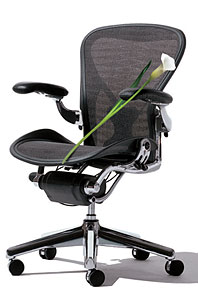
Bill Stumpf, who died recently at age 70, isn’t the first person you’d associate with the dot-com boom, but as the co-designer of Herman Miller’s Aeron Ergonomic office chairs—sleek, stark, arachnoid, made of high-tech composites—he created the ultimate symbol of that time of optimism. They became shorthand for the countless companies that didn’t have a clue how to make money on the Internet, but, man, did they have the know-how to set up a cool office. Back then, Aeron chairs retailed for over $1,100 apiece, came in three sizes, were infinitely adjustable, and made you feel like you were commanding a space battle cruiser instead of typing HTML and waiting for those stock options to vest. Aerons were hailed as triumphs of industrial design and were a whole different beast from the overstuffed leather power chairs that dominated the Old Economy. “They’re not in my mind an example of hubris as much as they are an example of companies trying to treat their staff more generously than they could actually afford,” says information architect Chris Fahey.
Then the bubble burst. Fahey remembers that Aerons “piled up in a corner as a kind of corporate graveyard after they laid off 95 percent of the staff in about two months” at his then-employer (some of those ended up as seating at the company he then founded, Behavior Design, and he sits on one to this day). Many companies sold them off en masse. The Aeron chair was the first acquisition that Paola Antonelli made when she became associate curator of the architecture and design department at MoMA (in ’94, she points out, well before the tech boom). “I love how wonderfully obsessed he was,” Antonelli says about Stumpf. “He concentrated his whole life on office chairs. The Aeron chair was the fruit of decades of work and came to signify a new paradigm in office chairs. In the beginning, one chair fit all. The Aeron was three chairs, and the customization happens within the chair. There’s a lot of innovation, both technological and also behavioral.” And they didn’t go away, although the price has dropped below $900. Nathaniel Wice, who launched the online encyclopedia altculture.com, still has two Aerons in his home office (he says he bought them new in ’99 with money he made from “flipping dot-com IPOs”). He sees them as both chair and retro symbol. “There’s nothing more nostalgic than ideas of the future that have been passed by,” he says.
“The dearest image I have of the chairs is visiting the lobby of the World Trade Center,” Antonelli says. “All of the people at the reception desk were sitting in Aeron chairs.” Next: Area Nudists Escape to Jersey Beach
Have good intel? Send tips to intel@nymag.com.